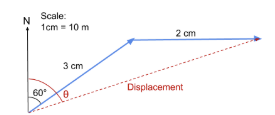Mechanics
1/34
Earn XP
Description and Tags
Name | Mastery | Learn | Test | Matching | Spaced |
|---|
No study sessions yet.
35 Terms
SUVAT
Equations of motion that can be used when an object is moving at uniform acceleration
Distance
Scalar quantity that describes the amount of ground the object has covered
Displacement
Vector quantity that describes the overall distance travelled from the starting position
Speed
Scalar quantity that describes the distance travelled per unit time
Velocity
Vector quantity that describes the rate of change of displacement
Acceleration
Vector quantity that describes the rate of change of velocity
Uniform acceleration
Where the acceleration of an object is constant
Area under acceleration-time graph
Velocity
Gradient of velocity-time graph
Acceleration
Area of velocity-time graph
Displacement
Gradient of displacement-time graph
Velocity
Instantaneous velocity
The velocity of an object at a specific point in time
Resolving vectors
Splitting a vector into its vertical and horizontal components
Adding vectors using trig
Used when two vectors are perpendicular to each other. Use Pythagoras’ theorem to find the magnitude and trigonometry to find the direction
Adding vectors using a scale drawing
Used when vectors are at angles other than 90°. Use a ruler and protractor to find the magnitude and direction, making sure to note the scale used

Projectile motion
Vertical and horizontal components of a projectile’s motion are independent. Use SUVAT in two dimensions, ignoring air resistance so acceleration is constant
Free-body diagrams
A diagram which shows all the forces that act on an object
Newton’s first law
An object will remain at rest or travelling at a constant velocity, until it experiences a resultant force
Newton’s second law
The acceleration of an object is proportional to the resultant force experienced: F=ma
Newton’s third law
For each force experienced by an object, the object exerts an equal and opposite force
Terminal velocity
Frictional forces acting on an object are equal to the driving forces, so there’s no resultant force and no acceleration
Gravitational field strength
The force per unit mass exerted by a gravitational field on an object: g=F/m
Weight
The gravitational force that acts on an object due to its mass: W=mg
Momentum
The product of the mass and velocity of an object: p=mv
Principle of conservation of momentum
Momentum is always conserved in a closed system. Total momentum before = Total momentum after
Moments
The turning effect of a force. Force multiplied by the perpendicular distance from the line of action of the force to the point: Moment=Fx
Principle of moments
For an object in equilibrium, the sum of anticlockwise moments about a pivot is equal to the sum of clockwise moments
Centre of gravity
The point at which gravity appears to act
Uniform object
Centre of gravity is exactly at its centre
Work
The force causing a motion multiplied by the distance travelled in the direction of motion: W=FΔs
Kinetic energy
The energy an object has due to its motion
Gravitational potential energy
The energy an object has due to its position in a gravitational field
Principle of conservation of energy
Energy cannot be created or destroyed, only transferred from one form to another
Power
The rate of energy transfer
Efficiency
A measure of how efficiently a system transfers energy